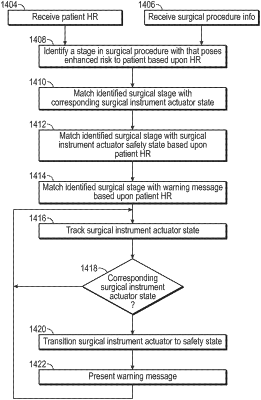| CPC A61B 34/35 (2016.02) [A61B 34/10 (2016.02); A61B 34/20 (2016.02); A61B 34/25 (2016.02); A61B 34/37 (2016.02); G16H 20/40 (2018.01); G16H 40/67 (2018.01); A61B 2017/00477 (2013.01); A61B 2018/00595 (2013.01); A61B 2018/00988 (2013.01); A61B 2034/107 (2016.02); A61B 2034/252 (2016.02); A61B 2034/254 (2016.02); A61B 2034/256 (2016.02); A61B 2090/031 (2016.02); A61B 90/37 (2016.02)] | 23 Claims |

|
1. A method of controlling a surgical system that includes at least one robotic surgical instrument and a surgical instrument actuator comprising:
receiving at an electronic user interface, surgical procedure information that identifies multiple surgical stages of a surgical procedure, each of the multiple surgical stages being a particular procedure of a plurality of procedures for performing the surgical procedure on a surgical patient with one or more robotic surgical instruments;
receiving at the electronic user interface, first health record information of a surgical patient that identifies a first health characteristic of the surgical patient;
using a processor configured with computer program code, to identify a first surgical stage of the multiple surgical stages of the surgical procedure that poses enhanced risk to the surgical patient, based upon the first health characteristic of the surgical patient and a first information structure stored in a non-transitory computer readable storage associating the identified first surgical stage of the surgical procedure with a first enhanced risk related to the first health characteristic of the surgical patient;
using the processor configured with computer program code, to identify a first actuation state, of different actuation states, of a first robotic surgical instrument of the one or more robotic surgical instruments and a first safety actuation state of different safety actuation states of the first robotic surgical instrument, based upon the first information structure stored in the non-transitory computer readable storage associating the identified first surgical stage of the surgical procedure with the first actuation state of the first robotic surgical instrument and the first safety actuation state of the first robotic surgical instrument, wherein the first information structure associates different actuation states with different safety actuation states for one or more of the multiple surgical stages with one or more health characteristics of the surgical patient and one or more enhanced risks related to a one or more health characteristics of the surgical patient, wherein the first information structure associates the first health characteristic of the one or more health characteristics of the surgical patient with each of: the first surgical stage of the multiple stages of the surgical procedure, the first enhanced risk of the one or more enhanced risks associated with the one or more health characteristics of the surgical patient, the first actuation state of the different actuation states and the first safety actuation state of the different safety actuation states;
receiving user input commands from a user to control movement of the first robotic surgical instrument;
tracking surgical instrument actuation state of the first robotic instrument during movement of the first robotic surgical instrument in response to the user input commands, the first robotic surgical instrument transitioning to the first actuation state associated with the first surgical stage;
matching, using the first information structure, the first health characteristic of the surgical patient with the first surgical stage that poses the first enhanced risk to the surgical patient;
matching, using the first information structure, the first surgical stage that poses the first enhanced risk to the surgical patient with the first actuation state of the different actuation states that is indicative of the first surgical stage;
determining, using the first information structure and responsive to matching the first surgical stage that poses the first enhanced risk to the surgical patient with the first actuation state of the different actuation states, to transition the first robotic surgical instrument to a safety mode operation using the first safety actuation state of the different plurality of safety actuation states identified in the first information structure for the first actuation state of the different actuation states; and
transitioning the surgical instrument actuation state of the first robotic instrument to the first safety actuation state associated with the first surgical stage in response to the determination.
|